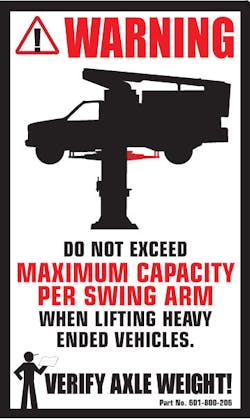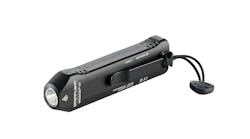Shops considering the purchase of a new vehicle lift are encouraged to confirm the lifting equipment, and any additional accessories used with the equipment, meets certain certification standards, advise lift manufacturers. Signage on and around the lift, with regard to lift instructions and labeling, is also required.
Buy Certified
There is only one nationally recognized safety standard for vehicle lifts: ANSI/ALI ALCTV. These acronyms stand for the American National Standards Institute, Automotive Lift Institute and Automotive Lift Construction, Testing and Validation, respectively.
This standard is administered by the ALI (www.autolift.org), a trade association of vehicle lift manufacturers which works with a nationally recognized independent testing laboratories to verify that lift manufacturers meet and comply with accepted industry safety and performance standards. The testing includes verification of the structural integrity of a lift’s systems and components, proper function of its controls and appropriate lowering speeds and overload protection.
To verify a lift’s status, look for the gold ALI Certified/Validated label on the lift. This label indicates that the lift has been tested and certified to meet the current ANSI/ALI ALCTV standards.
Be Selective with Lift Options
A commonly overlooked mistake is using an uncertified option or accessory on a certified lift. Doing so will void the lift’s certification and could put safety and lift performance at risk.
ALI/ETL, ANSI and IBC (International Building Code) standards require that all accessories – such as rolling jacks, truck adapters, lighting for runway lifts and special lifting pads – be certified. The lift’s rated load capacity and use of an accessory should also be taken into account.
Although, product certification typically remains valid for the life of the lift, when relocated, older models may not meet the most current safety standards or building code requirements.
Additional Safety Signage and Devices
Every ALI certified lift should have an ALI Safety Tips Card visible for all technicians to access and view while operating the lifting equipment. There is also other safety signage and devices shops may consider implementing in their facilities to aid in safer lift operation.
For signage, shops can affix additional signage to the lift itself which indicates proper usage and warning labels. To request free safety and usage labels, go to www.mohawklifts.com/brochures.
Another item to consider is a weight gauge. Essentially, this is a pressure gauge that converts psi to pounds. This provides technicians a simple visual indicator to confirm the load weight of the vehicle on the lift.
Proper Lift Usage
Lift manufacturers recommend that technicians always lower the lift onto the locks. A weight gauge allows technicians to quickly and accurately confirm that the load has been transferred to the mechanical locks to ensure proper usage of the lift.
This can also be used as a recordkeeping tool to ensure proper lift usage by each technician.
Revenue Generator
A weight gauge can provide a visual indicator for customers, along with a discussion on previous services, to determine if parts and components wore prematurely based on an overloaded vehicle. For instance, it can help a shop’s technicians justify selling heavier shocks and heavy duty brakes to generate additional revenue.
Takeaway
There are a number of factors to consider before and after the purchase of a lift to ensure the safest and most efficient use of that equipment. Key among them is lift standards, certification and labeling. As was noted previously, the only nationally recognized safety standard for vehicle lifts is ANSI/ALI ALCTV, administered by the ALI.
Contributing to this article was Steve Perlstein, president, Mohawk Lifts (www.mohawklifts.com).


